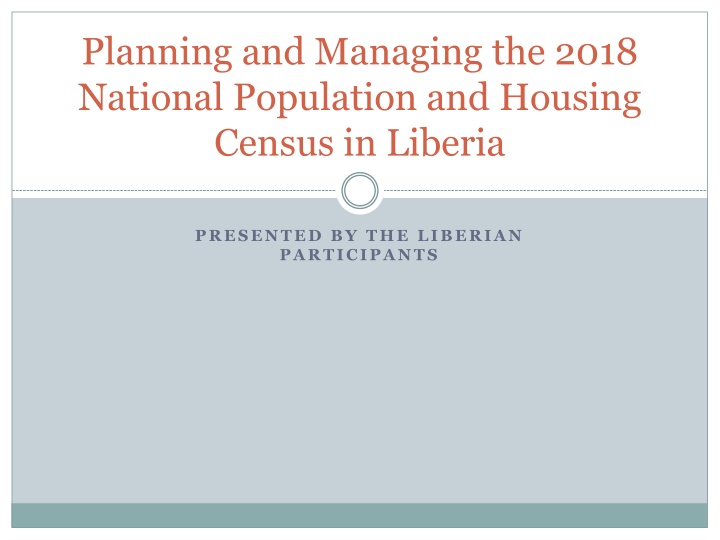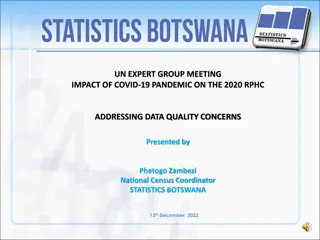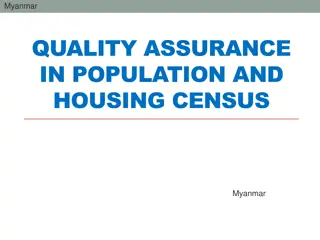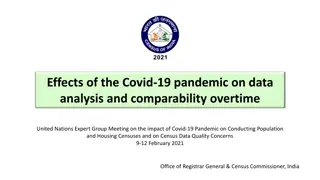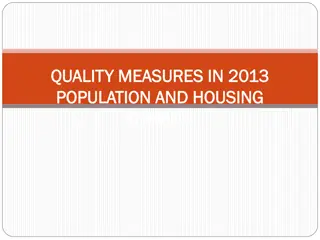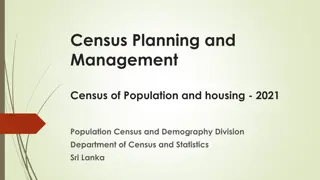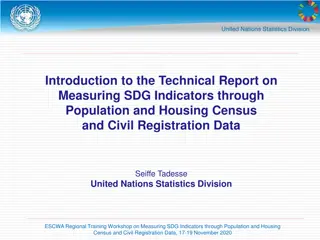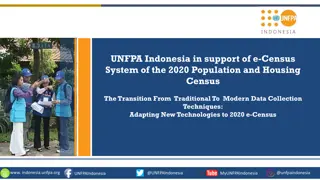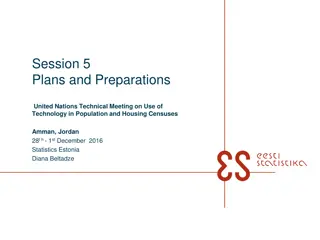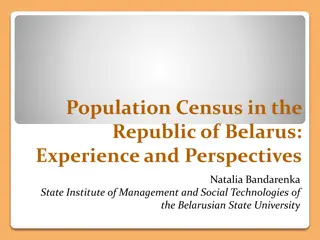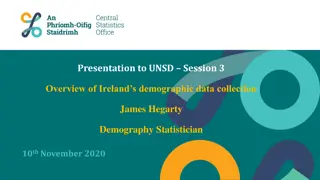Planning and Managing the 2018 National Population and Housing Census in Liberia
Liberia conducted its 2018 Population and Housing Census to provide relevant data for development planning, policy formulation, and service delivery. The census, mandated by Article 39 of the Constitution, aimed to improve citizens' quality of life and support development programs. The project involved phases like project formulation, establishing census machinery, and defining census scope and coverage.
Download Presentation

Please find below an Image/Link to download the presentation.
The content on the website is provided AS IS for your information and personal use only. It may not be sold, licensed, or shared on other websites without obtaining consent from the author.If you encounter any issues during the download, it is possible that the publisher has removed the file from their server.
You are allowed to download the files provided on this website for personal or commercial use, subject to the condition that they are used lawfully. All files are the property of their respective owners.
The content on the website is provided AS IS for your information and personal use only. It may not be sold, licensed, or shared on other websites without obtaining consent from the author.
E N D
Presentation Transcript
Planning and Managing the 2018 National Population and Housing Census in Liberia PRESENTED BY THE LIBERIAN PARTICIPANTS
Background Liberia has conducted four censuses in 1962, 1974, 1984 and 2008 which revealed a constantly growing population of 1.1 million, 1.5 million, 2.1 million and 3.5 million inhabitants, respectively.
Objectives The objective of the 2018 Liberia Population and Housing Census is to contribute to the improvement of quality of life of the people by providing the Government and other stakeholders with relevant, reliable and timely social, demographic and economic data and information for development planning, policy formulation and service delivery as well as for monitoring and evaluation of development programmes and plans.
Legal framework The legal basis for the census in Liberia is in Article 39 of the Constitution which states that the Legislature shall cause a census to be undertaken every 10 years. Therefore, as part of its main functions and responsibilities, LISGIS should Conduct censuses and surveys .
Phases of the 2018 NPHC The main components of the census project can be broken down into the following logical phases of implementation: Preparatory phase which includes: a. Project Formulation and Planning - Due to the complex nature of the census operations, careful planning is required at the outset to formalize and guide the process. A Project Document has been developed to specify the logical phases of the undertaking, spell out the involvement of key institutions and Partners with the various inputs, costs and timelines to be adhered to. The Project Document must first be endorsed by the Government of Liberia before it is shared with other census partners.
Phases (contd) b. Establishment of Census Administrative and Organizational Machinery - A census administrative and organizational machinery has been establish to oversee the census programme. This involves setting up of the various census organs like the Census Partnership and Census Technical Committees plus the Census Secretariat. This sets the census operations apart from the normal duties of the Liberia Institute for Statistics and Geo-Information Services.
Phases (contd) c. Determination of Scope and Coverage of the Census - The determination of the scope of the census can be done by the Liberia Institute for Statistics and Geo-Information Services (LISGIS) working in concert with government Ministries, Departments and Agencies, and Development Partners. It is instructive to hold a Users Conference where various interest groups would contribute towards the determination of the content of the census. The inclusion of modules and questions on the questionnaire is guided by cost considerations in terms of time and resources. Issues that require far deeper and special treatments are better reserved for specialized surveys.
Phases (contd) d. Donors Conference - Given the current budgetary and statistical capacity of the country, Government cannot fund the census operations on her own. The contribution of Donors will be crucial to the timely completion of the various census activities. Liberia has very few traditional (resident) Donors. Donors need to be consulted early in the census calendar to get their commitments, ascertain the amount of outside contributions and funding gap after discounting for Government s contribution.
Phases (contd) e. Publicity, Advocacy and Resource Mobilization - Census publicity is one of the first activities that involve the wider public in the operations of the project. It makes the general public to be aware of the various census activities, solicits their buy-in, contributes towards national ownership, substantially supports advocacy and, thereby, facilitates timely acceptance of the programme, resource mobilization and extensive use of the census results and products. Given its importance, various strategies and media will be employed to transmit appropriate census messages to different audiences at various levels of Government, interest groups and the public at large. The Census Publicity Unit should have a close affinity between it and the Ministry of Information and independent media houses and local artists.
Phases (contd) f. International Procurement and Recruitment of Key Census Experts - Once the preliminary preparations well- advanced, start-up funds are made available and the census calendar starts in earnest, a resident Chief Technical Adviser, Census Cartographer/GIS and Publicity/Advocacy Experts are recruited. Also, procurement procedures should be started to timely secure supplies of census mapping and data processing materials. International procurement and recruitment of these take at least 6-8 months and would, therefore, have to be planned for very early in the census calendar to avoid unnecessary delays.
Phases (contd g. Development of Census Instruments and Pilot Census - The preparation of the various census mapping, data collection and processing materials will get underway with the resident technical advisers in post. Care should be taken to get all the instruments ready in time for the Pilot census which should happen about 6-8 months before the main census to see the efficiency of strategies and effectiveness of instruments devised for the census-taking. Any unsatisfactory outcome of use is rectified after the pretest. At this stage, a Tabulation Programme is developed to guide the production of analysis and publication tables at advance stages of the census programme.
Timeframe for the Entire Census Operation The timeframe for the entire census operation will be three years and six months (January 2016-June 2019) and is tentatively summarised below:
Time Frame No. MAIN PHASES PERIOD 1. 2. 3. 4. 5. 6. 7. 8. 9. Preparatory Phase Cartographic Mapping Pilot Census Field Enumeration Post-Enumeration Data Processing Data Analysis Publication of Census Results Dissemination of the Results Jan. 16-April 18 Nov. 16-Oct. 18 June 17 21st-27thMarch 18 April 18-July 18 April 18-Sept. 18 Sept. 18-Feb. 19 March 19-Jun. 19 April 19-Jun. 19
Conclusion Thank you for your attention!!!
